#P. Éluard
Text

Un homme aux yeux légers décrit le ciel d'amour.
Il en rassemble les merveilles
Comme des feuilles dans un bois,
Comme des oiseaux dans leurs ailes
Et des hommes dans le sommeil.
/ Paul Éluard
19 notes
·
View notes
Text

Je n'ai vraiment plus besoin d'ailes
Pour calciner ma pesanteur
/ Paul Éluard
35 notes
·
View notes
Text
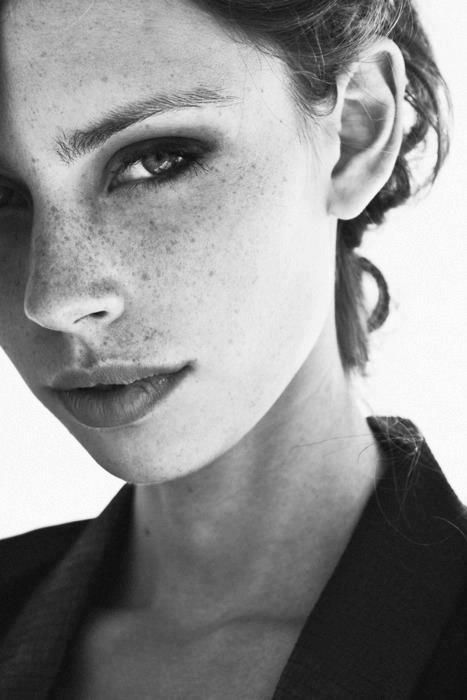
E la tua bocca
silenziosa può rivelarsi
l'impossibile…
|| P. Éluard
15 notes
·
View notes
Text
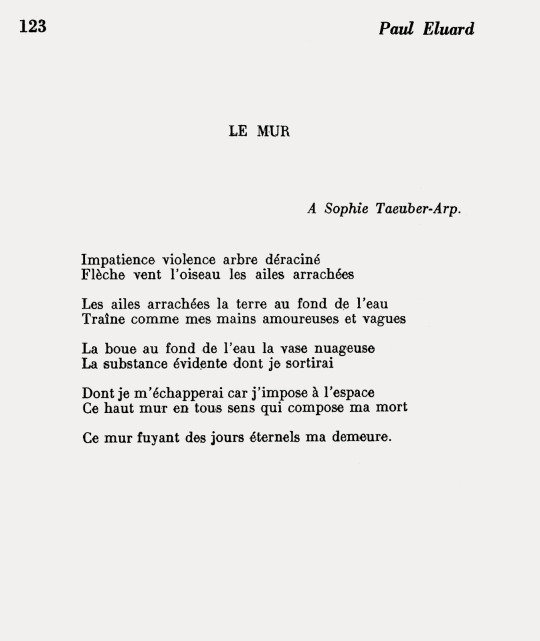
Paul Éluard, Le mur (A Sophie Taeuber-Arp), in Paul Éluard. Nouvelle édition refondue et augmentée, «Poetes d'aujourd'hui» 1, Foreword by Louis Parrot, Afterword by Jean Marcenac, Éditions Pierre Seghers, Paris, 1965, p. 123
#graphic design#poetry#book#paul éluard#sophie taeuber arp#louis parrot#jean marcenac#éditions pierre seghers#éditions seghers#1960s
12 notes
·
View notes
Text
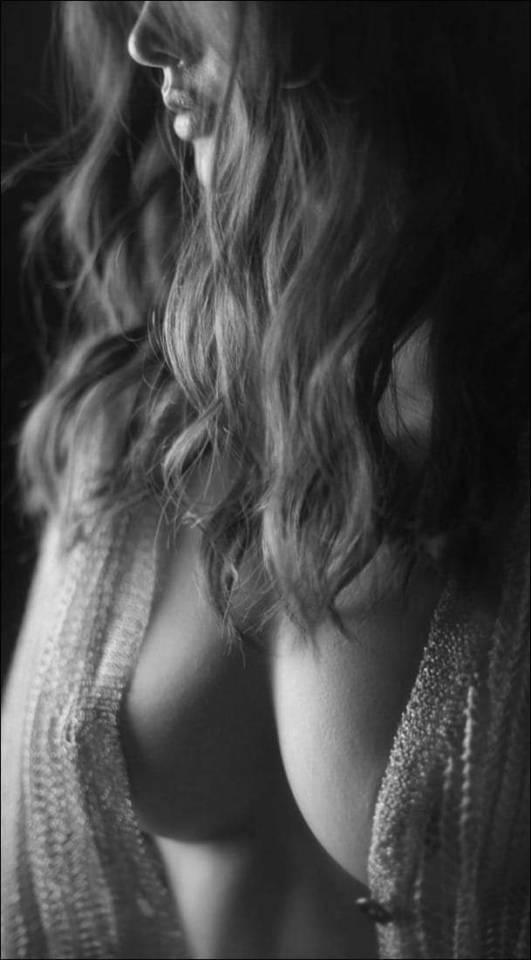
Lei è in piedi sulle mie palpebre
e i suoi capelli sono nei miei,
lei ha la forma delle mie mani,
lei ha il colore dei miei occhi,
lei è sprofondata dentro la mia ombra
come una pietra sopra il cielo.
Lei ha sempre gli occhi aperti
e non mi lascia dormire.
I suoi sogni in piena luce
fanno evaporare i soli,
mi fanno ridere, piangere e ridere
parlare senza avere niente da dire.
P. Éluard
63 notes
·
View notes
Photo
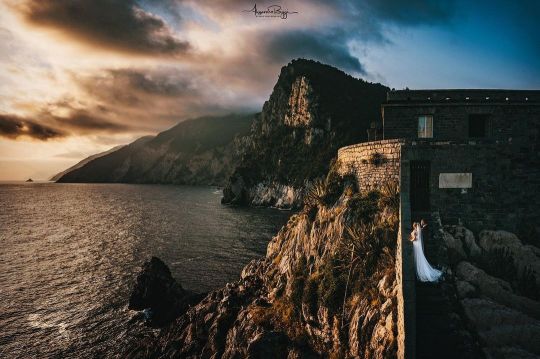
È a partire da te che ho detto sì al mondo. (Paul Éluard) ❤️❤️ da uno dei luoghi più belli e magici…Porto Venere SP Italy - With “Love.” S + A ⭕️PRENOTAZIONI APERTE per nuovi MATRIMONI ⭕️ Info e Link in BIO ➡️ @alessandrobiggi_wedding ⬅️⭕️ #dress #cinqueterre #sony #versilia #destinationwedding #wedding #lunigiana #weddingday #tuscanywedding #liguriawedding #weddingphotography #matrimonio #weddingitaly #weddingtuscany #instawedding #weddingparty #weddingideas #love #weddingphoto #weddingtime #ispwp #engagement #portovenere #dreamwedding #weddings #weddingphotographer #luxurywedding #anfmshare #sarzana @sony @sony.italia @sonyalphaproitalia @sonykorea @sonygroup_jp @anfm_fotografi_matrimonialisti @proweddingphotographers_ispwp @fearlessphotographerscom (presso Portovenere Cinque Terre, Italy) https://www.instagram.com/p/Cd7omNjsF-B/?igshid=NGJjMDIxMWI=
#dress#cinqueterre#sony#versilia#destinationwedding#wedding#lunigiana#weddingday#tuscanywedding#liguriawedding#weddingphotography#matrimonio#weddingitaly#weddingtuscany#instawedding#weddingparty#weddingideas#love#weddingphoto#weddingtime#ispwp#engagement#portovenere#dreamwedding#weddings#weddingphotographer#luxurywedding#anfmshare#sarzana
3 notes
·
View notes
Text
BIOGRAFIA RESUMIDA DE PAUL DELVAUX (1897/09/23 - 1994/07/20)
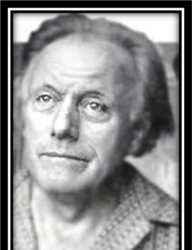
Nació el 23 de septiembre de 1897 en Antheit, Lieja, (Bélgica).
Desde 1904, asiste al colegio St. Gilles de Bruselas, donde le fascinan los esqueletos del laboratorio de biología. Esto y la lectura de las célebres novelas de Julio Verne se convertirán en el centro de su pintura: dos personajes, un geólogo y un astrónomo, aparecerán con frecuencia en sus obras.
Cursa estudios de griego y latín. En 1916 entra en la Academia de Bellas Artes de Bruselas y da clases de arquitectura que dejará un año después.
Conoce a Frans Courtens que convence a sus padres del talento artístico del joven pintor y desde 1919 se dedica a la pintura. En 1920, conoce a Anne-Marie de Martelaere, llamada Tam, quien será el gran amor de su vida.
Pinta paisajes en la tradición realista de sus amigos del grupo Le Sillon y participa en varias exposiciones junto con Magritte, Baugniet y Flouquet. Desde 1925 pinta obras de gran formato, marcadas por el expresionismo, "El banco", de 1927, y en ese año, expone en la Galería Manteau de Bruselas. En el año 1930 entra en contacto con el surrealismo y hacia 1929-1930, se encuentra con una Venus, la del "Gran Museo Anatómico Etnológico del Dr. P. Spitzner", en una barraca de curiosidades en la Feria del Midi, en Bruselas, que mostraba al público ejemplos de malformaciones congénitas.
En 1932 pinta su primera "Venus dormida", que acabará por destruir. En 1933 el Palacio de Bellas Artes de Bruselas le organiza una exposición individual. En junio de ese año pinta "Mujeres y piedras". En 1936 realiza una exposición junto a René Magritte en el Palacio de Bellas Artes de Bruselas. En 1937, contrae matrimonio con Suzanne Purnal.
Participa en la Exposición Internacional del Surrealismo organizada por André Breton y Paul Éluard en la Galerie des Beaux-Arts, de París. Recibe el premio de la Academia Picard y viaja por primera vez a Italia. Pinta Ninfas bañándose. En 1939 viaja por segunda vez a Italia, donde visita Pompeya y Herculano. En 1940-42 participa en la Exposición Internacional del Surrealismo, de México. En 1944-45 el Palacio de Bellas Artes de Bruselas le organiza una retrospectiva. En 1947 realiza los decorados para el ballet Adame Miroir, de Jean Genêt. De 1949 a 1957 realiza una serie de crucifixiones y enterramientos en los que el tema de los esqueletos se hace obsesivo.
0 notes
Text

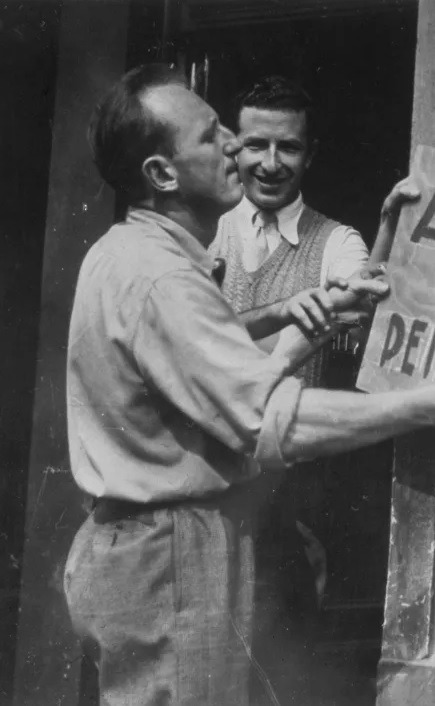
Plaque en hommage à : Martin et Karl Flinker
Type : Œuvre
Adresse : 68 quai des Orfèvres, 75004 Paris, France
Date de pose :
Texte : Ici fut de 1948 à 1988 l'illustre librairie et maison d'édition de Martin et Karl Flinker, dont les amis se nommaient Th. Mann, R. Musil, H. Hesse, H. Broch, S. Zweig, P. Celan, Michaux, Éluard, Aragon, Queneau
Quelques précisions : Martin Flinker (1895-1986) et son fils Karl (1923-1991) sont deux libraires et éditeurs autrichiens. Martin ouvre sa première librairie à Vienne en 1933, via laquelle il publie ses Almanachs. Il fuit l'Autriche avec Karl quelques années plus tard en raison de l'Anschluss et séjourne un temps en Suisse, puis passe par plusieurs villes de France avant de s'établir temporairement à Tanger. Après la Seconde Guerre mondiale, père et fils s'installent à Paris, où ils ouvrent une nouvelle librairie qui deviendra un haut lieu de la culture allemande en France, et comptera parmi ses clients des intellectuels tels que Paul Celan, Gabriel Marcel ou Alfred Kastler. Karl ouvrit également une célèbre galerie d'art à Paris.
1 note
·
View note
Text
C'è un altro mondo, ma è in questo.
— P. Éluard
0 notes
Text

Je vais la tête la première
Saluant d'un secret nouveau
La naissance des images.
/ Paul Éluard
19 notes
·
View notes
Text

T Y P O: Journal of Lettrism, Surrealist Semantics & Constrained Design
TYPO 2 is now available
Contents include: alien alphabets, prismatic subdivisions, principles of double-talk, Post-Neoist portraits, desiring specimens, asemic architecture, Paul Éluard poetry, titular typography, Surrealist trivia, Italian eye candy, curlicues in review, generic sheet music, Jarry on the English language, historical filler text translations & much more
Journal Details:
Title: TYPO 2
Author: Various
Language: English
ISBN 979-8-9869224-5-4
Format: Paperback Journal
Pages: 152
Publisher: Black Scat Books
Contributors:
Pierre Albert-Birot; Guillaume Apollinaire; Mark Axelrod-Sokolov; Tom Barrett; Allan Bealy; Miggs Burroughs; Jahan Cader; Janina Ciezadlo; Norman Conquest; Farewell Debut; R J Dent; Karen Eliot; Paul Éluard; Paul Forristal; Ryan Forsythe; Jesse Glass; Rick Henry; Rhys Hughes; Rory Hughes; Alfred Jarry; Richard Koman; Márton Koppány; Amy Kurman; Peter F. Murphy; Pata-No UN LTD; Gaston de Pawlowski; Derek Pell; Harry Polkinhorn; Tom Prime; Jason E. Rolfe; Ded Rysel; Doug Skinner; Giovanni Antonio Tagliente; Félix Vallotton; Andrew C. Wenaus; Adolphe Willette; Carla Wilson; William Wordsworth.
Publisher’s details:
Purchase links:
US: https://www.amazon.com/dp/B0BZFLSJ95
UK: https://www.amazon.co.uk/dp/B0BZFLSJ95
Can: https://www.amazon.ca/dp/B0BZFLSJ95
Aus: https://www.amazon.com.au/dp/B0BZFLSJ95
#TYPO 2#literary journal#R J Dent#Alfred Jarry#Paul Éluard#Black Scat Books#www.rjdent.com#Lettrism#semantics#surrealism#asemic writing#Speculations#Capital of Pain
0 notes
Photo

#LoQueNosHaceSerFelicesEsEstarAgradecidos 🙏🏼🤭🥰 —— No hay más que una vida, por lo tanto es perfecta. Paul Éluard 🙌😻♥️🍹 (en Son Lo Que Me Hacen Ser Yo) https://www.instagram.com/p/Cgnb1yvDLVX/?igshid=NGJjMDIxMWI=
0 notes
Text
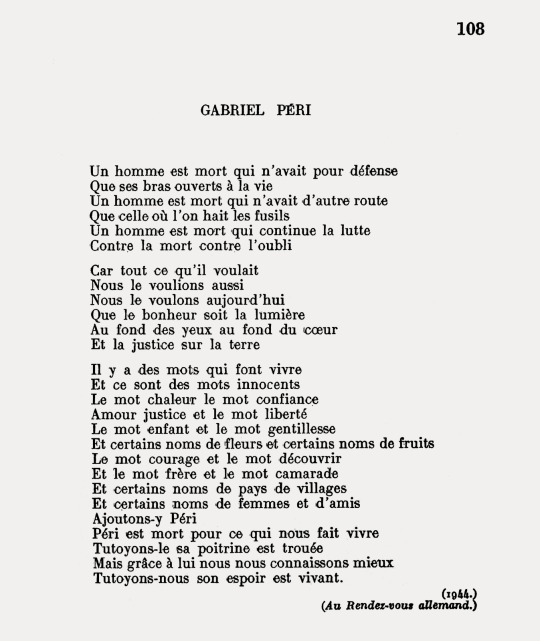
Paul Éluard, Gabriel Péri [from Au Rendez-vous allemand (1944)], in Paul Éluard. Nouvelle édition refondue et augmentée, «Poetes d'aujourd'hui» 1, Foreword by Louis Parrot, Afterword by Jean Marcenac, Éditions Pierre Seghers, Paris, 1965, p. 108
#graphic design#poetry#book#paul éluard#gabriel péri#louis parrot#jean marcenac#éditions pierre seghers#éditions seghers#1940s#1960s
17 notes
·
View notes
Photo

One day you get up and see yourself featured with the legendary poets of the world. No, I didn't feel thrilled, exhilarated, or chuffed. I just wept a silent tear, as anything meaningful I have created has a sorrow behind it. My poem The Tree, translated into Portuguese by Francis Kurkievicz and published in the Brazilian journal Rivista Acrobata (link in the bio). Thanks to the editor. In the great company of Forough Farrokhzad (Irã, 1935-1967), Miguel Márquez (Venezuela, 1955), Natalie Diaz, José Carlos Becerra (México, 1936-1970), Kristin Dykstra (United States, 1970), Samar Shahdad (Iran), Nadia Anjuman (Afghanistan, 1980-2005), María Ángeles Pérez López (Spain, 1967), Mía Gallegos (Costa Rica, 1953), Rita Dahl (Finland, 1971), Carina Sedevich (Argentina, 1972), Zofia Beszczyńska (Poland, 1951), Renée Ferrer (Paraguay, 1944), Elsie Surena (Haiti, 1956) and legends like Hans Arp (French-German / 1886-1966), Maurice Blanchard (France 1890-1960), Paul Éluard (France, 1895-1952) Juan Eduardo Cirlot (Spain, 1916-1973) Nishiwaki Junzaburo (Japan 1894-1982), Aimé Césaire (Martinica, 1913-2008), Célie Diaquoi-Deslandes (Haiti, 1907-1989), Rubén Bonifaz Nuño (México 1923 – 2013), Stella Díaz Varín (Chile 1926 – 2006), Louis Scutenaire (Bélgium, 1905-1987), Radovan Ivsic (Croácia, 1921-2009), Alice Rahon (France, 1904-1987), Dusan Matic (Serbia, 1898-1980), De Joyce Mansour (England, 1928-1986), Leopoldo María Panero (Spain, 1948–2014), Jorge Gaitán Durán (Colômbia, 1924-1962), Max Blecher (Romania, 1909-1938), Olga Orozco (Argentina, 1920-1999), Aimé Césaire (Martinique, 1913 – 2008), Kansuke Yamamoto (Japan, 1914 – 1987), Marianne Van Hirtum (Belgium, 1925-1988), León-Gontran Damas (Guyana, 1912-1978), Valentine Penrose (France, 1898-1978), Dusan Matic (Serbia, 1898-1980) and some others. #tree #thetree #poetry #poetsofinstagram #translation #pourtuguese #legends #revista #revistaacrobata #KSC https://www.instagram.com/p/Cet3-gGvVet/?igshid=NGJjMDIxMWI=
1 note
·
View note
Text
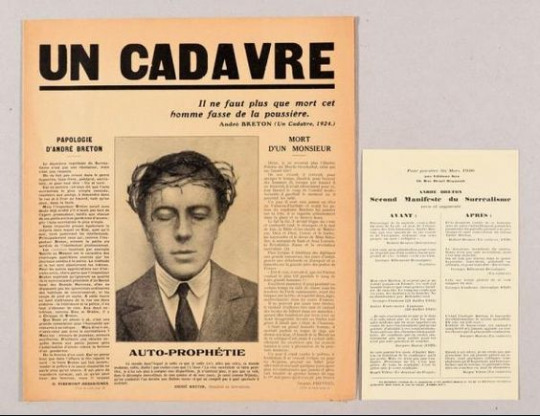
(Tract) - Un cadavre. Paris, Imp. sp. du Cadavre, [15/1/1930] Un double f., 37 x 32 cm (impression sur papier journal lég. bruni, un pli horizontal central). Bon ex. Deuxième pamphlet surréaliste portant ce titre, après celui de 1924 signé par Breton, Soupault, Éluard, Drieu La Rochelle, Delteil et Aragon, dirigé contre Anatole France. Illustré sur la première page d'un portrait photographique de Breton, les yeux fermés et couronné d'épines. Non moins virulent, il est dirigé contre Breton après la parution du "Second manifeste du surréalisme" dans le numéro 12 de "La Révolution surréaliste"; il se présente comme un ensemble de contributions individuelles par G. Ribemont-Dessaigne ("Papologie d'André Breton"), J. Prévert, R. Vitrac ("Moralement puer"), M. Leiris, G. Limbour, J.-A. Boiffard, R. Desnos, M. Morise, G. Bataille ("Le lion châtré"), J. Baron ("Un bon débarras") et A. Carpentier.
Joint : Avant Après. S.l., s.n., [février 1930]. Un f., 24 x 15 cm (pli horizontal central). Tract de Breton contre les rédacteurs du pamphlet supra; il y oppose leurs déclarations à son égard "avant" et "après" la publication du second manifeste et annonce sa parution chez Kra fin mars 1930.
Réf. Biro e.a., Dict. général du surr., p. 416 & 408. (2 pcs)
auction.fr
4 notes
·
View notes
Photo
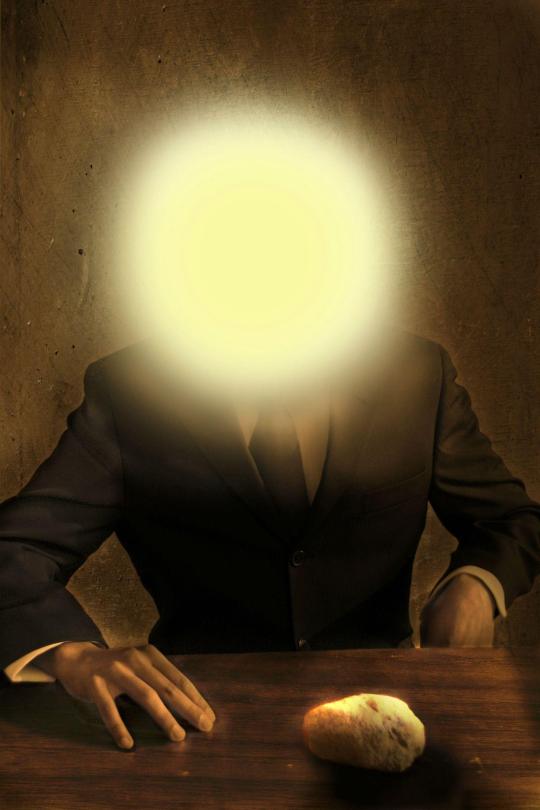
Rene Magritte Painting
The Pleasure Principle (Portrait of Edward James), 1937.
Painted in 1937, René Magritte’s ‘Le Principe du plaisir (The Pleasure Principle)’ is an entrancing portrait that depicts Edward James, one of the most influential patrons of Surrealist art, who was introduced to Magritte by Salvador Dalí in 1937. Commissioned directly by James, the present portrait was rendered from a photograph of the patron that was taken according to the artist’s specifications by fellow Surrealist, Man Ray. Magritte envisioned the concept for the present work before ever meeting James – in 1936, the artist included an ink sketch resembling the oil on the first page of a hand-made book honoring the Surrealist poet, Paul Éluard. A highlight of Sotheby's Impressionist & Modern Art Evening Sale on 12 November, this mesmerizing work is now on view in Sotheby's New York galleries.
Le Principe du plaisir (The Pleasure Principle), painted in 1937, showcases several enduring and recognizable themes from Magritte’s oeuvre: visual and cerebral paradox, an uncanny alteration of the familiar and the tension between the visible and the hidden. The painting is a portrait of Edward James, an English heir to an American railroad fortune turned eccentric poet and influential patron of Surrealist art. After Dalí introduced James to Magritte in 1937, James immediately invited the artist to spend the winter months at his Wimpole Street house in London, and for two years James commissioned a number of paintings from the burgeoning Surrealist. Of these commissions, two are portraits of the patron: La Reproduction interdite (Not To Be Reproduced) and the present work.
Magritte envisioned the concept for Le Principe du plaisir before ever meeting James. In 1936 Magritte included an ink sketch resembling the present work on the first page of a hand-made book honoring the surrealist poet, Paul Éluard. Beneath the drawing, Magritte writes “pour Paul Éluard (Idée de Paul Colinet)." This inscription may refer to Marcel Mariën’s claim that Paul Colinet submitted the idea for portrait manqué (failed portrait), or a portrait with an invisible or hidden face, to Magritte, albeit after the artist had been obscuring the likeness of his subjects for nearly a decade.
Then, in June 1937, several months after his stay at James’ Wimpole Street home, Magritte presented the idea of this portrait in a letter to James: “I have done a picture representing a man whose head is a light…I consider it as a preliminary study, the real picture as I envision is still to be painted but since it would be intended for you, do you not think your person could be recognized in it as well? If the idea appeals to you, all you have to do is be photographed full-faced at a table with your arms crossed and resting on the table and a sort of stone lying on the table to your right and not too far from your arm. And send me the photograph” (quoted in D. Sylvester, ed., René Magritte Catalogue Raisonné, op. cit., pp. 249-50). James commissioned fellow surrealist Man Ray to take his photograph, which he quickly mailed to Magritte for the portrait. When Magritte finished the painting in September and had it delivered to James in London, James told Magritte in a letter, “My friend and I think it is a great success, in fact a work of genius” (quoted in ibid., p. 250).
The title of the painting refers to a key element of Freudian psychoanalysis, which served as a philosophical underpinning for the Surrealist movement. However, Magritte himself has warned against interpretations and analysis of his titles: “The titles of pictures are not explanations and pictures are not illustrations of titles. The relationship between title and picture is poetic, that is, it only catches some of the object’s characteristics of which we are usually unconscious, but which we sometimes intuit, when extraordinary events take place which logic has not yet managed to elucidate” (quoted in J. Levy, ed., René Magritte: Selected Writings, Minneapolis, 2016, p. 112).
Edward James, a poet and a lifelong collector of art, is particularly remembered for his patronage of Surrealist painters including Dalí, Margritte, Tchelitchew, Fini and Carrington. He provided space for his artist friends to develop their creative practice. Dalí, Tchelitchew, Magritte and others were given studio space during extended stays in Edward's homes at West Dean and in London. He supported them further through commissions and collaborations, building one of the finest collections of Surrealist art in the world. Le Principe du plaisir remained in James' collection until 1964 when it became a part of his eponymous Foundation. It was acquired by the present owner in 1979 and has remained in the same private collection for nearly forty years.
Impressionist and Modern Art Evening Sale, Sotheby's, NY, 12 November 2018
Lot 35
René Magritte
1898 - 1967
LE PRINCIPE DU PLAISIR
Estimate
15,000,000 — 20,000,000 USD
Signed magritte (upper left); titled "Le Principe du plaisir," signed Magritte and dated 1937 (on the reverse)
Oil on canvas
28 3/4 by 21 1/2 in.
73 by 54.5 cm
Painted in 1937.
Source: www.artdependence.com
49 notes
·
View notes